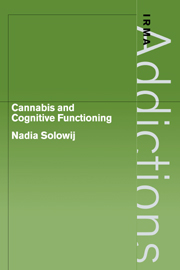Book contents
- Frontmatter
- Contents
- Series editor's preface
- Author's acknowledgements
- 1 Statement of the problem
- PART 1 A REVIEW OF THE LITERATURE
- PART 2 RESEARCH
- 7 An event-related potential study of attentional processes in long-term cannabis users
- 8 An investigation of the effects of frequency and duration of cannabis use
- 9 An investigation of the reversibility of cognitive impairment in ex-cannabis users
- 10 A single case study of cessation of cannabis use
- 11 Anxiety, psychopathology and the qualitative experience of long-term use of cannabis
- 12 Summary, synthesis and conclusions
- Appendix
- References
- Index
7 - An event-related potential study of attentional processes in long-term cannabis users
from PART 2 - RESEARCH
Published online by Cambridge University Press: 16 September 2009
- Frontmatter
- Contents
- Series editor's preface
- Author's acknowledgements
- 1 Statement of the problem
- PART 1 A REVIEW OF THE LITERATURE
- PART 2 RESEARCH
- 7 An event-related potential study of attentional processes in long-term cannabis users
- 8 An investigation of the effects of frequency and duration of cannabis use
- 9 An investigation of the reversibility of cognitive impairment in ex-cannabis users
- 10 A single case study of cessation of cannabis use
- 11 Anxiety, psychopathology and the qualitative experience of long-term use of cannabis
- 12 Summary, synthesis and conclusions
- Appendix
- References
- Index
Summary
Studies prior to the 1990s provided little information as to the nature of any specific deficits associated with the long-term use of cannabis, although attentional mechanisms were often implicated. As argued in Chapter 5, one reason for the equivocal nature of results from past studies may be that the tests used were insufficiently sensitive to detect subtle dysfunction of specific cognitive processes. There has been relatively little use of quantitative measures derived from experimental cognitive psychology in any studies of chronic drug-related deficits.
The advent of brain event-related potential (ERP) recording technology allowed for the simultaneous assessment of electrophysiology, cognition and behaviour and the detection of subtle dysfunction in specific stages of information processing. The interpretation of ERP components is based on modern theories of cognition and information processing. The series of studies described here employed these techniques to address the question of the existence and nature of attentional deficits in long-term cannabis users.
The paradigm selected to assess the efficiency of attentional mechanisms was a complex multidimensional auditory selective attention task based on that developed by Hansen & Hillyard (1983). This task was selected for two reasons. First, because of the inherent complexity of the task. An in depth examination of the literature suggested that impairments would most likely be detected only in cognitively demanding tasks involving interference. Second, because there exists a wealth of normative data on the ERP patterns elicited by this paradigm, as well as data from a number of other clinical groups suspected of deficient attentional mechanisms, for example schizophrenics (Michie et al., 1990b; Ward et al., 1991). The precise nature of the task is described in detail below.
- Type
- Chapter
- Information
- Cannabis and Cognitive Functioning , pp. 135 - 151Publisher: Cambridge University PressPrint publication year: 1998

